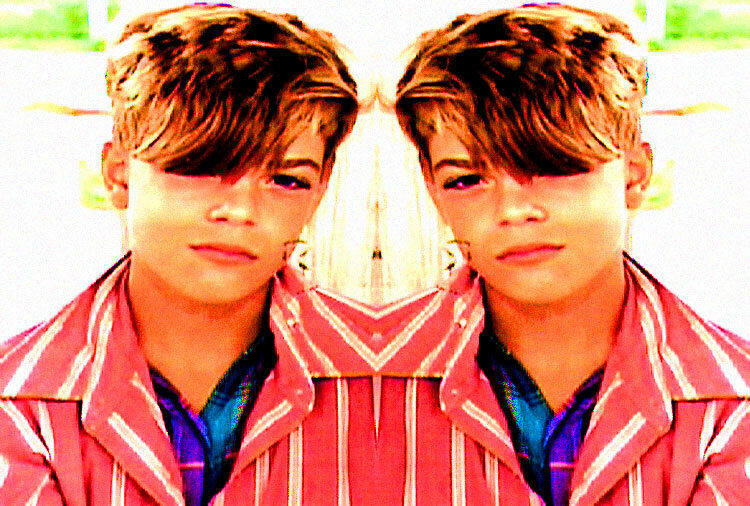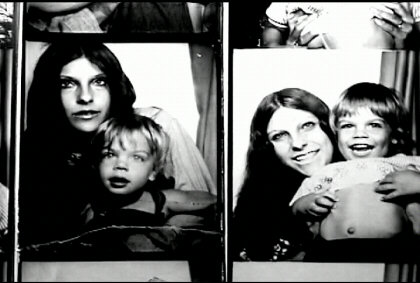
Tarnation:
The Dream of Autobiography
Reviewed:
Tarnation,
Jonathan Caouette, 2004
It may never quite reach a multiplex near you, but Tarnation, Jonathan Caouette’s first film, has just upended convention at every festival it has hit. Tarnation is an intensely personal – and, well, just intense – documentary by the 31-year-old Caouette. It’s not that the “personal documentary” genre did not exist before – Ross McElwee and Michael Moore established their own personal doc styles decades ago and there has been a recent spate of “home movie” documentaries such as Andrew Jarecki’s Capturing the Friedmans (2003). But “personal documentary” has been a genre that attempted to represent reality, whereas Caouette’s film suggests that his recent life has been a 19-year-long dream.
We are clued in to this notion of the dream state from the beginning. An early scene in the film depicts a conversation between Jonathan Caouette and his boyfriend, David Sanin Paz. Lying on the couch, Jonathan groggily mumbles that he has just had a dream about his mother. When his boyfriend gently asks if it was a nightmare, Caouette replies, “yes.” This film is a record of that long, strange dream that also couches itself as an autobiography and family saga.
Heavily filtered through the muddled, often beautiful and always self-absorbed consciousness of the filmmaker, this film depicts a family trapped by the effects of mental illness, drugs and abuse. Cutting together bits of Super 8mm film, tape recorded audio, snapshots and video taken during the course of his life, Caouette documents a youth spent in the care of Renee, his schizophrenic mother, and his eccentric grandparents who, according to Caouette, have subjected their young daughter to years of shock treatments for a nonexistent mental illness. The film’s introductory section is like a whirlwind – no, a Texas tornado – through Caouette’s earliest years. Extremely fast cuts reminiscent of the drug-induced sequences in Aronofsky’s Requiem For a Dream (2000), mirroring effects reminiscent of early music videos, and iMacked Warholian mass-reproduction effects abound. Images flash, morph, and change colors in a circuit-overload of sensory expression. Interwoven with these hyperactive and hypertextured interludes, onscreen messages of inconsistent sizes regularly appear to tell the story of Caouette’s family.
Jonathan has had his own run-ins with psychoactive substances. As Caouette tells us in the film, when he was a young teenager, he smoked two joints that had (unbeknownst to him) been laced with PCP – and, as he describes it, “was never the same afterwards.” As the onscreen titles put it, he developed “dissociative disorder,” meaning that he could no longer concentrate, and that he felt like “an outside observer of [his] own mental processes.” The final definition for the disorder that Caouette offers is that it’s like “living in a dream.” The nightmarish collage of images seems intended to depict the early parts of his life as he experienced them.
 This information, like much of the other facts or observations in the film, are brought to us courtesy of Caouette’s ubiquitous intertitles. The titles serve a curious function, but one that seems entirely consistent with the rest of the film: they serve to simultaneously pull us in and push us away. The titles seem to beckon with tantalizing bits of information (e.g. “Renee was hospitalized over 100 times”) but they lack the personal vocal inflections of a voiceover, and are also written in the third person. In his intertitles, Caouette generally refers to all the “characters” in the film by their first names, including himself. That is, his mother, Renee LeBlanc, is “Renee”; he himself is “Jonathan” (as in, “Jonathan staged suicide attempts almost weekly”); and his grandparents are, bleakly, Rosemary and Adolph. Without comforting first-person voiceovers, this impersonal documentary, ostensibly from a third person point of view, goes through the (e)motions of dissociation itself. It’s as if Jonathan can’t quite bear to get close enough to his early years to fully explore them. Instead, he keeps himself and the audience at arm’s length from his childhood, with “dissociation” and “dreaming” as the explanation. (It is also interesting how Caouette’s accidental mental illness mirrors that of his mother; both were fine until she was given shock treatment, and he smoked a joint.) This is an understandable expressive choice, but a frustrating one for Caouette, let alone for the audience member longing to connect with him.
This information, like much of the other facts or observations in the film, are brought to us courtesy of Caouette’s ubiquitous intertitles. The titles serve a curious function, but one that seems entirely consistent with the rest of the film: they serve to simultaneously pull us in and push us away. The titles seem to beckon with tantalizing bits of information (e.g. “Renee was hospitalized over 100 times”) but they lack the personal vocal inflections of a voiceover, and are also written in the third person. In his intertitles, Caouette generally refers to all the “characters” in the film by their first names, including himself. That is, his mother, Renee LeBlanc, is “Renee”; he himself is “Jonathan” (as in, “Jonathan staged suicide attempts almost weekly”); and his grandparents are, bleakly, Rosemary and Adolph. Without comforting first-person voiceovers, this impersonal documentary, ostensibly from a third person point of view, goes through the (e)motions of dissociation itself. It’s as if Jonathan can’t quite bear to get close enough to his early years to fully explore them. Instead, he keeps himself and the audience at arm’s length from his childhood, with “dissociation” and “dreaming” as the explanation. (It is also interesting how Caouette’s accidental mental illness mirrors that of his mother; both were fine until she was given shock treatment, and he smoked a joint.) This is an understandable expressive choice, but a frustrating one for Caouette, let alone for the audience member longing to connect with him.



This Land was Your Land:
A Review of Philip Roth
James Russell
Am I Religious?
Jay Michaelson
Down and Out in the Slipper Room
Joshua Axelrad
Tarnation: The Dream of Autobiography
Lauren Wilson
Money-Back Guarantee
Samantha Stiers
Sitting on an aeroplane, while Grandma Dies
Nigel Savage
Archive
Our 580 Back Pages
Zeek in Print
Fall/Winter 2004 issue now on sale
About Zeek
Mailing List
Contact Us
Subscribe
Tech Support
Links
From previous issues:
Art at War
Bara Sapir
Bush the Exception
Samuel Hayim Brody
Life During Wartime
Jay Michaelson